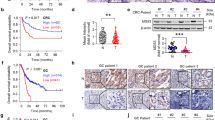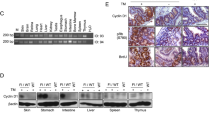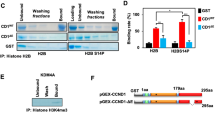Abstract
Cyclin D1 in cooperation with its major catalytic partners, cyclin-dependent kinases cdk4 and cdk6, facilitates progression through the G1 phase of the eukaryotic cell cycle, in part through phosphorylation of the retinoblastoma protein. Cyclin D1's oncogenic properties have been suggested by its cooperation with ras or adenovirus E1a to transform cultured cells, as well its overexpression in transgenic mice that leads to breast cancer. Activated by a number of different mechanisms in human cancers, the cyclin D1 gene is frequently amplified in squamous epithelial cancers derived from the head/neck and esophageal regions. In order to study the functional consequences of cyclin D1 overexpression in these squamous epithelial specific sites, we have linked the Epstein-Barr virus ED-L2 promoter to the human cyclin D1 cDNA and utilized this transgene to generate founder lines. This transgene is transcribed specifically in the tongue, esophagus and forestomach, all sharing a stratified squamous epithelium. The transgene protein product localizes to the basal and suprabasal compartments of these squamous epithelial tissues, and mice from different lines develop dysplasia, a prominent precursor to carcinoma, by 16 months of age in contrast to age-matched wild-type mice. This transgenic model is useful in demonstrating cyclin D1 may be a tumor initiating event in aero-upper digestive squamous epithelial tissues.
This is a preview of subscription content, access via your institution
Access options
Subscribe to this journal
Receive 50 print issues and online access
$259.00 per year
only $5.18 per issue
Buy this article
- Purchase on SpringerLink
- Instant access to full article PDF
Prices may be subject to local taxes which are calculated during checkout
Similar content being viewed by others
Author information
Authors and Affiliations
Rights and permissions
About this article
Cite this article
Nakagawa, H., Wang, T., Zukerberg, L. et al. The targeting of the cyclin D1 oncogene by an Epstein-Barr virus promoter in transgenic mice causes dysplasia in the tongue, esophagus and forestomach. Oncogene 14, 1185–1190 (1997). https://doi.org/10.1038/sj.onc.1200937
Received:
Revised:
Accepted:
Issue date:
DOI: https://doi.org/10.1038/sj.onc.1200937
Keywords
This article is cited by
-
Construction and Quantitative Evaluation of a Tissue-Specific Sleeping Beauty by EDL2-Specific Transposase Expression in Esophageal Squamous Carcinoma Cell Line KYSE-30
Molecular Biotechnology (2023)
-
Notch signaling drives development of Barrett’s metaplasia from Dclk1-positive epithelial tuft cells in the murine gastric mucosa
Scientific Reports (2021)
-
Generation and characterization of an inducible transgenic model for studying mouse esophageal biology
BMC Developmental Biology (2012)
-
Neoadjuvant in situ gene-mediated cytotoxic immunotherapy improves postoperative outcomes in novel syngeneic esophageal carcinoma models
Cancer Gene Therapy (2011)
-
Conditional transformation of rat embryo fibroblast cells by a cyclin D1-cdk4 fusion gene
Oncogene (1999)



